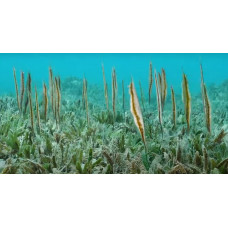Latin name
Aeoliscus strigatus
Other names
Jointed razorfish, coral shrimpfish.
Identification
Body very strongly compressed laterally, with sharp ventral edge; dorsal profile of body straight; almost completely covered with thin, transparent bony plates. Snout elongated; tubular; jaws long, pincer-like; mouth tiny, toothless. Interorbital space convex, furrowed; longitudinal furrow absent. At the very end of the body is a long, flexible, sharp barb, followed by two shorter barbs. The first barb is hinged at the base, making it mobile; the end of the barb is also mobile. The lateral line is absent.
Features of fish fins
The dorsal fin with 10 soft rays and the caudal fin are located in the posterior part of the body and shifted to the ventral side. The anal fin has 12 soft rays. The pectoral fins are large with 11-12 soft rays. The small pelvic fins are located in the center of the body.
Fish colouring
Body coloration varies with environmental conditions. The upper body can be yellowish-brown to pale green; the sides are silvery with a dark line running down the center of the body from the snout to the caudal fin. Specimens inhabiting aquatic vegetation are usually greenish-yellow with a blurred stripe, while those inhabiting sandy or gravelly substrates are paler with a black median stripe.
Distribution
Widespread in the Indo-Pacific region from eastern Africa (including Madagascar, Comoros, and Seychelles) to Australia and New Caledonia; northward to Japan. In Australia they are found from Cape York Peninsula to northern New South Wales.
Habitat
Tropical marine benthic fish. They live on coral reefs in sheltered bays at depths from one to 42 meters.
Size
The maximum body length is 15 centimeters.
Behavior
Swims slowly in small schools in an upright position with head down and back to front. Commonly seen among Octocorallia, Scleractinia and black corals, crinoids and sea urchins of the Diadematidae family, and sea grasses.
Food and feeding habits
Feeds on small zooplankton. Prefers small marine shrimp and other small invertebrates. Eats small crustaceans. Marked ontogenetic shifts in diet: juveniles feed predominantly on copepods, while adults prefer amphipods.
Reproduction
This species is oviparous, and the eggs and larvae lead a pelagic lifestyle. Juveniles settle when they reach 20 millimeters (0.79 inches) in length, often preferring to live among the spines of Diadema setosum.
Fishing
Not interesting for fishermen.
Relationship with a person
Used in aquariums.
Interesting Facts
Razorfish usually swim in groups in an upright position - head down, belly forward. This makes a group of these fish look very interesting - like soldiers on parade. This behavior is an adaptation so that these fish can hide between the barbs of the sea urchin in case of danger.
| Classification | |
| Phylum | Chordata |
| Class | Actinopterygii |
| Squad | Syngnathiformes |
| Family | Centriscidae |
| Genus | Aeoliscus |
| Species | A. strigatus |
| Features | |
| Conservation status | Data Deficient |
| Habitat | Bottom |
| Life span, years | No information |
| Maximum body weight, kg | No information |
| Maximum length, cm | 15 |
| Sailing speed, m/s | No information |
| Threat to people | No information |
| Way of eating | Planktonophage |
Razorfish
Tags: razorfish



